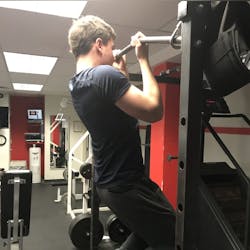3 Lifestyle Choices That Make All the Difference
The fire service provides its firefighters with the most advanced technology, training and gear. The men and women who graduate from a fire academy have been screened, tested, evaluated, trained and prepared to attack their duties with gusto and bravado. But what happens 10 or 15 years down the road? The fires and related dangers never get old, sick, tired or jaded. Fires are always energy bombs, waiting to explode their deadly forces. We, however, get older, heavier, more sedentary and probably plagued with a host of aches and pains, which can spell disaster on a fireground.
Every fire is a man vs. nature event, one that man could never win under ordinary circumstances. But with modern technology and superior training, we do actually stand a chance. Fortunately, there is one additional variable that has a major impact on the outcome of any incident—a variable that the firefighter has complete control of—the firefighter themselves.
You are the key
The single most essential tool you take to every call is you. The relationship between a firefighter’s health and their job performance is essential to their ability to perform at the highest level of efficiency within the often-dangerous environments.
As you age through your 40s and 50s, physiological changes occur that are the results of lifestyle choices made during those years from 25 to 45 or 50. Let’s face it, most people don’t get stronger and healthier as they advance through the decades. While the responsibilities and equipment always weigh the same, it is a firefighter’s responsibility to arrive safely to the scene, perform their duties at the highest level of efficiency and then go home.
Being in shape is not an optional element of our jobs. The only way to significantly reduce the risks of a fatal and serious event on the fireground is to enter the scene in the best possible health and fitness you are capable of achieving. If you are in your best possible physical condition, free from chronic illness and disease, you have significantly reduced the risks of potential injury or death.
According to the U.S. Fire Administration’s report “Fire Fatalities in the United States in 2016,” 10 percent of fire response fatalities are attributable to falls at the scene, while 20 percent of fatalities are attributed to being struck by an object, a fatal assault, a structural collapse, becoming lost inside, caught underwater diving, exposure to fumes, and alcohol overdose. Another 25 percent of fatalities are attributable to crashes that occur while responding to or leaving a scene or during training. But the key number here: 42 percent of our brothers and sisters die from over-exertion, stress, cardiovascular disease, hypertension and other medical conditions. Most, if not all, are created by poor lifestyle choices. However, through support and some hard work, are all treatable and reversible.
3 lifestyle choices
The three most impactful lifestyle choices a human being can make to maximize personal health and wellness are related to nutrition, physical fitness and stress. For an active firefighter, the choices made regarding these three variables may be the difference between life and death on the fireground or, unfortunately, hours later, after the event, when the firefighter has retuned home to their family.
Nutrition
Eating as close to whole as possible is a great starting point. That means eating foods that are known to promote beneficial health for optimal body function and to avoid processed. Consumption of whole foods, such as fruits, vegetables and high-quality proteins that have been proven to maximize health, should be the main components of a healthy diet that promotes optimal health.
Every state of processing that a food undergoes degrades its nutrient profile. Food-processing adds salt, sugar, fatty oils and food additives (dyes, emulsifiers, preservatives, etc.) and morphs it into a food-like item that was originally nutrient-dense (high in nutrients, low in calories) but now just a product that claims to be of equally strong nutritional value as its parent food. However, the processed food is much higher in calories and much lower in usable nutrients.
An example of this is the processing of potatoes into potato chips. The potato provides vitamins, minerals, fiber and a host of other essential nutrients, with a low caloric profile and a much less expensive price tag than potato chips. The chips provide a much higher profile of fat, salt, coloring and other processing agents that then becomes a high-calorie, low-nutrient profile (empty calories) food-like item.
Some items that are high in nutrients and low in calories include berries, salmon, 100 percent whole grains (but not too much), chicken breast, grass-fed/free-range meats, all vegetables, olive oil and water (instead of juice and sodas). Avoid high intakes of sugar, salts, fatty oils, dyes and preservatives, all of which are the hallmark of processed foods.
Two very helpful strategies for success are to use smaller plates for meals (we tend to eat whatever is on the plate) and to keep a food journal to track your progress.
Fitness
The role of positive, healthy physical fitness, combined with eating nutrient-dense foods is a one-two punch in defense of developing health risks. It is the most powerful instrument a firefighter can depend on to “level the playing field” in their favor, and every little bit of protection in a firefighter’s approach is critical to their survival.
Aerobic fitness benefits the heart, blood vessels, lungs and total body fitness. Although exercise is essential for a healthy lifestyle, many people are uncomfortable going to a gym or doing “formal” workouts—but you don’t need to. Some examples of aerobic exercises include walking, jogging, bicycle riding, walking, similar recreational sports, and even chasing your kids round the playground all fit the criteria of fitness, weight management and cardiovascular health. The goal of exercise is to create “controlled stress” for the body to become more fit and for firefighters to reduce the risks of a cardiovascular event.
As you engage in these activities, you increase the capacity of the heart and circulatory system to deliver oxygen and nutrients to the cells of the body for energy and all physiological processes. As the heart and circulatory system becomes more fit, the results are a much healthier system working at full capacity and efficiency with minimal stress and strain on the heart and blood vessels (arteries, veins and capillaries).
Regardless of the exercise, some generally accepted guidelines are to perform moderately intense exercise three to five times a week, for about one hour per session. For someone newly embarking on an exercise routine, it is essential to get a medical “go-ahead “from your doctor, and start slowly until you feel you can get more intense.
Stress
Stress and the release of the stress hormone cortisol that support the stress reaction are all potentially under your control based on the lifestyle choices you make. Meditation, exercise, stress management, yoga and other modalities are available to support the management of your stress. Of course, we are under a constant daily bombardment of stress, not at all related to the fire service. There is little we can do to avoid stressful situations in our daily lives. However, how a person reacts to and deals with stress is totally under personal control.
The ability to control your responses to stressful situations is oftentimes habitual and learned behavior that you have used to successfully in the past. However, like most habitual and learned behavior, some serve us well and some are detrimental to our emotional and physical health. If you handle stress well, the benefits are tremendously healthful. Some things that have been proven to help are walking away from situations that you know you don’t react well to and keeping a stress journal that describes the event, your response and what you could have done differently to reduce that level of stress. Additionally, exercise reduces stress.
It's up to you
The combination of nutrient-dense foods, moderately intense exercise and stress management may well hold the key to a lifetime of health with a significant reduction in the risks that lead to a chronic illness and disease, a lifetime on meds and tragedy on the fireground.
In the final analysis, keeping our firefighters safe on route to an alarm, during fire suppression and returning home safely is the fire service’s top priority. With the joint efforts of the fire service and the firefighter, the risks of serious injuries and death can be reduced significantly.
Note: Any proposed changes in lifestyle should always include your personal medical physician’s approval.
Reference
U.S. Fire Administration. “Fire Fatalities in the United States in 2016.” December 2017. FEMA.
About the Author

Robert Blaufarb
Robert Blaufarb is a former captain with 25 years of service, currently serving as the director of health and wellness for The Town of Mamaroneck Fire Department in Westchester County, NY. He can be reached at [email protected].
